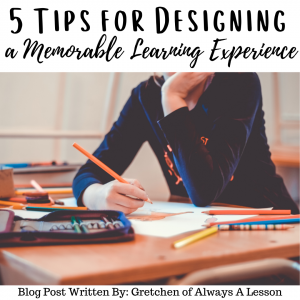5 Tips for Designing a Memorable Learning Experience
 Teachers write lesson plans, but rarely do they actually DESIGN a learning experience. Why is this?
Teachers write lesson plans, but rarely do they actually DESIGN a learning experience. Why is this?
Traditional teaching programs focus on the theory of teaching with a sprinkle of actual techniques for how to teach. Part of that how-to process is writing a lesson plan. The emphasis is on all of the components necessary to fill out a pre-structured lesson plan outline, rather than on the art of designing a learning experience.
We need to move from compliance to creation. That means we put down those pre-structured lesson plan outlines in exchange for employing our knowledge and expertise to create a memorable learning experience for all students every day.
This post is the first in a series of posts (1 of 3) to help teachers grow one instructional strategy at a time.
5 Tips for how to Become a Lesson Designer instead of a Lesson Planner
Tip 1: Design a Learning Experience that Moves Students towards Independence
The goal of a lesson is to teach students a new skill. This is followed by allowing them ample time to practice that skill in a variety of settings to build muscle memory. These two steps lead up to the culmination of the lesson where students are able to showcase the skill on their own. This formula is often referred to as the I Do – We Do – You Do cycle, meaning the teacher models the skill, the students practice with the teacher, and finally they can do it on their own.
Tip 2: Design a Learning Experience that Provides Structure
Students thrive in a routined environment. Therefore, teachers should provide structure to not only how they deliver a lesson, but how students interact during it. This means the teacher designs learning structures throughout the lesson (ie. morning work, gathering materials, transitioning to centers, etc.). Although the procedures for these learning structures remains constant daily, the work students do within those structures changes. Students are able to become more successful because they are familiar with the structure, allowing them to use their brain power to focus on content rather than on logistics. In turn, this frees up the teacher to focus on providing more individualized learning support to students rather than helping them navigate the structures. Also, because the content changes within the structures, students do not become bored with the repeated routine.
Tip 3: Design a Learning Experience that Guides and Supports
It is no secret that students learn at all different rates and in a variety of ways. This means the teacher has to design a learning experience that allows for differing student needs. Differentiation is a way to guide and support students along their learning journey.
There are three ways to do this:
- Differentiate Content – Teach content based on the achievement level of the students. Data collection will help determine where students are in relation to grade level expectations. Although you are teaching to their personal level, be sure to mix in grade level content so that they will be ready to progress at the end of the year.
- Differentiate Process– Teach the same content to all students, but the strategy you use to teach it will differ. Some students might need learning aides like math manipulatives or reading sight word cards. Learning styles help teachers choose the most effective teaching process necessary for students.
- Differentiate Product– Teach the same content in the same way, but allow students to showcase their learning in a variety of ways. Teachers can supply a choice board for students to select the method in which they will present their learning. Students get excited to use their strengths to demonstrate their learning (ie. diorama, speech, PowerPoint presentation, etc.)
Tip 4: Design a Learning Experience that Challenges Students’ Skillsets
As mentioned earlier, students progress as learners at different speeds. Some students will be ready for an extension of the learning opportunity before the end of the lesson arrives. These early finishers have learned the skill, demonstrated the skill successfully and are ready to use that skill in a new way to continue their learning. By providing a menu of challenge options for those that need it will not only help keep them on task, but also enhance the learning experience for those students as well.
Tip 5: Design a Learning Experience that is Planned to the Detail
This last tip is crucial and often forgotten. Many lesson plan outlines do not even require teachers to think through the nitty gritty details of the lesson and that is what trips up teachers when it comes time to delivering their instruction.
It is imperative that teachers walk through the lesson from start to finish to ensure they leave no stone unturned. This means thinking through every teacher and student action (FYI: a T-Chart works best). Teachers should know what they are saying and doing at every point in the lesson as well as what students should be saying, doing or producing. This kind of detail ensures the lesson moves smoothly and at a rigorous level. (No, it does not have to be written verbatim as a script, but highlighting those details throughout the lesson ensures it is designed to the detail!)
Next Steps
Ready to give your lesson planning process an overhaul so that you can begin designing learning experiences that stick? Grab a slot on my calendar to chat 1:1 about your specific students and instructional needs or reach out to me personally at [email protected].
GO BE GREAT!
How do you create memorable learning experiences in your own classroom?

